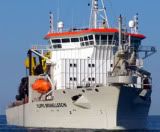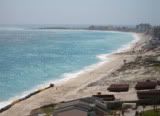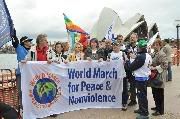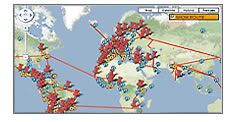Come on now, you’ve heard this one before, if you haven’t, the story goes something like this; due to the immense popularity of Cancun over the last forty years to both national and international tourists, development along the Mexican Caribbean has been so widely successful that new hotels and sleepy fishing villages have blossomed into mega municipal wide resorts up and down the coastline, covering some eighty plus miles and two islands, Isla Mujeres and the long popular Isla Cozumel. Fortunately or unfortunately, depending on your perspective, this increased development has created the never ending need to cater to future visitors as a matter of convenience, and if you believe the folks in government responsible for tourism in Mexico, the need to handle more arrivals and departures up and down the coast of Quintana Roo, Mexico to meet this burgeoning demand. That, and continued investment pressure from members of the Spanish Hotel industry, licking their chops at the opportunity to score the next massive resort hotel, on the backs of cheap labor and light fingered local politicians.

(Courtesy of InvestmentMexico)
In any case, courtesy of the Mexican Ministry of Communications and Resources or SCT, comes word of the prospective Invitation to Bid (ITB) for the construction and management of the new Riviera Maya Airport, and the ITB, is stated by the SCT, to be prepared and ready for presentation to prospective bidders by November of 2009. The SCT claims that the land acquisition has been finalized and that the land possession has been acquired by the Federal Government for the project. They also add that by the year 2025, they expect the region to be handling upwards of 17.9 million visitors, hence the need for the new facility, estimated to cost upwards of $300 million US dollars.
The new airport is slated to be approximately 102 kilometers (63 Miles) south of the privately managed ASUR, Cancun International Airport in an area frequently mentioned as Tulum but much closer to the nearby, rural, Village of Coba, named for the Maya ruins of the same name. In fact, a recent visit to the Maya Roads of Home at Coba by this writer exhibited more than a few lots for sale, that upon further discussion with locals in the area, was based on wild speculation of values to come once the airport project is formally announced.

(Church at the Village of Coba)
Not to long ago, someone in Cancun, brought to mind a high speed rail line connecting the towns from Cancun to Tulum with potential extension lines to popular interior destinations like the ruins at Chichen Itza, I thought it was a great idea.
But, then again, I’m just another gringo…
Dangers…
Posted by: Dangers @ 9:06 am
These days if we’re talking Cancun, especially during the current slow season, we must be talking the Beach Restoration Project. Sure, there’s low hotel occupancy, a smattering of swine flu around in a topic that may rear it’s ugly head worldwide in the later part of this year and early next, and then there’s the vacation sales discounts that haven’t been seen in years. But, despite it all, it’s beach restoration that has Cancun, along with her sister resort areas, Playa Del Carmen and Cozumel, in the Mexican State of Quintana Roo all a buzz.
The only problem is, the Beach Restoration Project has been delayed so many times that no one, and I mean no one, is ever quite sure what the scheduling of the work time line is going to be. And, hell there’s still the tropical storm season to deal with, well, two months of it anyway. However, rest assured, it’s going to happen, in fact the citizenry and government officials up and down Quintana Roo are bubbling with anticipation, at least as far south as Playacar, just south of Playa Del Carmen, the primary benefactor of restoration outside of Cancun. Now, we don’t want to keep you in anticipation of the coming events any further, just don’t hold your breathe or make life altering decisions based on the information we’re about to give you, as with everything in Mexico, the below announced dates and schedules are subject to change and/ or delays.

(Dredger at sea, Courtesy of Jan De Nul)
First the basics, Dredger ships are scheduled to arrive in Puerto Progreso, Yucatan this week from overseas, operated by the private contractor, Jan De Nul, along with Mexican subsidiary company Dragados, assigned the $80,000,000 US plus contract for the project. Machinery and submersible breakwaters are also scheduled to arrive along with them at an undisclosed location in Quintana Roo for the project. Prior to the actual depositing of sand, breakwaters will be established in designated areas of Cancun, Playa Del Carmen and Cozumel, so don’t gaze starry eyed at the incoming shipping and machinery, thinking that in a few short days that sand will appear miraculously over new, widespread, beautiful beach fronts.

(Cancun Beach Photo during Post Hurricane Wilma Restoration)
The sand used in the beach replenishment will actually have to be mined or dredged up from the ocean floor, the primary area of this sand mining to occur offshore of Cozumel at a marine area known as the North Bank. The area is stated to be an area where the confluence of oceanic currents occurs in the Caribbean Sea that naturally causes the the build up of large sand deposits. The Mexican Environmental Agency has cleared the area for sand extraction despite protests on Cozumel stemming from fears of the North Bank area providing a natural buffer from hurricanes and tidal surges. The same agency has also shot down the notion the area is productive breeding habitat for the endangered marine species, the Pink Conch. The secondary sand extraction area is also a marine area offshore of Isla Mujeres and Cancun.

(Beach Reclamation Equipment in action during previous work, Courtesy Jan De Nul)
The beach restoration project is expected to continue for at least 151 days from inception, ending on or about February 10, 2010. It is anticipated that topographical studies and bathymetry are already underway and will continue during the project to properly place man made breakwaters and additional submersible apparatus as required. In Cancun, the project will focus on the 12KM of beach between Punta Cancun and Punta Nizuc. In Playa Del Carmen, the main area of restoration is the Playacar area and in Cozumel, to a lesser extent, specific beaches are targeted for replenishment.
Reported Dates of Interest*:
Puerto Progreso, Yucatan
September 5, 2009: Estimated Arrival, Specialized Ships used for dredging, sand mining and bulk sand placement.
Cancun:
September 15, 2009 - December 28, 2009: Initial placement and construction of breakwaters in Cancun.
Early October, 2009- December 19, 2009: Beach Replenishment/ Addition of Sand to 12 KM of beach in Cancun.
Playa Del Carmen:
September 21, 2009 - November 19, 2009: Initial placement and construction of breakwaters in Playa Del Carmen.
December 11, 2009- December 20, 2009: Beach Replenishment/ Addition of Sand to select beaches
Isla Cozumel:
September 21, 2009 - November 19, 2009: Initial placement and construction of breakwaters
December 11, 2009- January 20, 2010: Beach Replenishment/ Addition of Sand to select beaches
*(All Dates Approximate and Subject to Delay, the information is deemed reliable but not guaranteed.)
The information in this edition of the Cancun Casa Blog was compiled from multiple sources, official and media related.
We’ll get a golden island…We’ll feed the food to the ford, And we’ll live off the coconut…
Dangers…



Every now and then, our blog here is going to go astray and off topic for what we believe is a very good cause, this is one of those times. For months now, there’s been a hyper-linked Earth Logo for the “The World March” on our sidebar indicating our endorsement of the World March For Peace and Nonviolence, we humbly ask our readers to take some time over the next few days to explore the World March site and join us in support of the multinational effort of citizens across the world to condemn war and violence in our time. The following descriptions and proposals below are courtesy of the World March and World Without Wars…

Why
Because we can end world hunger with 10% of what is spent on
arms. Imagine how life would be if 30-50% of the arms budget went
toward improving people’s lives instead of being used for destruction.
Because
eliminating wars and violence means leaving human pre-history behind
and taking a giant step forward in the evolution of our species.
Because
in this aspiration we are accompanied by the strength of the voices of
hundreds of prior generations who suffered the consequences of war, and
whose echo continues to be heard today in all those places where it
continues to leave its sinister trail of dead, disappeared, disabled,
refugees and displaced.
Because a “world without wars”
is an image that opens the future and seeks to become reality in every
corner of the planet, as violence gives way to dialogue.
The moment has come for the voiceless to be heard! Out of agonizing and urgent need, millions of human beings are crying out for an end to wars and violence.
We can make that happen by uniting all the forces of pacifism and active non-violence worldwide.
HOW CAN I SUPPORT THE WORLD MARCH?
It’s not too late to get involved and add your voice to the World March. Here’s how:
1) Endorse the World March as an individual or organization RIGHT HERE
2) Organize an event
or action in your neighborhood, workplace, school, or community in
support of the March between October 2nd and January 2nd. We have set
aside December 2nd as “World March USA Day” and are aiming to have hundreds of events organized across the country on that day.
3) If you already have an existing event
scheduled during this 3-month period, consider designating it “In
Support of the World March” and add it to our calendar of events. Your
support can be shown by including info on the March in your program, by
having a short presentation before or after the event, or by
incorporating the themes of the march into the content of your event.
4) Volunteer
with efforts to welcome and host the international team of marchers
when they visit NY, Washington, Los Angeles and San Francisco. November
30 – December 3. We need people to help with logistics, press,
publicity, graphic design, fundraising, and outreach. (info@worldmarchusa.net).
5) Spread the Word! Talk about the march with your family, friends, neighbors, co-workers and fellow students, and refer them to our website:www.worldmarchusa.net.
Thanks for joining us in the largest mobilization for peace and disarmament in history!
The World March for Peace and Nonviolence was launched during the
Symposium of the World Center for Humanist Studies held at the Park of
Study and Reflection in Punta de Vacas, Argentina, on November 15, 2008.
The World March aims to generate consciousness of the dangerous
global situation in which we are living, a situation marked by the
heightened probability of nuclear conflict, a renewed arms race, and
the violent military occupation of foreign territories.
The World March is a proposal for an unprecedented social
mobilization, advanced by the Humanist Movement through one of its
organizations, World Without Wars.
Since its initial proposal things have developed very quickly. In
just a few months the World March has received the endorsement of
thousands of people, pacifist and nonviolence groups, a variety of
institutions, and renowned figures from the worlds of science, culture,
and politics, who are sensitive to the urgency of the moment. It has
also inspired an enormous diversity of initiatives in more than 100
countries, becoming a rapidly growing human phenomenon.
(www.theworldmarch.org)
THE PRESENT SITUATION
Today we are experiencing a critical situation throughout the world,
characterized by poverty across vast regions and confrontations between
cultures. Violence and discrimination contaminate the daily life of
broad sectors of the population. Armed conflicts plague many areas, and
we now have a profound crisis in the international financial system.
Looming over all of these is the most pressing problem of all: the
growing nuclear threat. We are in a moment of extreme complexity. Not
only must we take into account the irresponsible interests of the
nuclear powers and the madness of violent groups with their potential
access to nuclear material, we must also consider the added risk of a
nuclear accident that could unleash a devastating conflict.
This is not just the sum of a few isolated crises; rather, we are
facing the global failure of a system whose methodology of action is
violence and whose central value is money.
THE PROPOSALS OF THE WORLD MARCH
To avoid a future nuclear catastrophe we must surpass violence today, demanding:
• nuclear disarmament at a global level;
• the immediate withdrawal of invading troops from occupied territories;
• the progressive and proportional reduction of conventional weapons;
• the signing of non-aggression treaties between countries;
• the renunciation by governments of the use of war as a means to resolve conflicts.
It’s urgent to create consciousness for peace and disarmament. But
it is also necessary to awaken a consciousness of nonviolence that
rejects not only physical violence, but all forms of violence:
economic, racial, psychological, religious, sexual, etc. This new
sensibility could take root and inspire the social structures, opening
the way towards the future Universal Human Nation.
We demand our right to live in peace and liberty. We do not live in liberty when we live under the threat of violence.
The World March is a call to all people to unite efforts and take
responsibility for changing the world, to overcome their personal
violence, and to work in their immediate environments, and as far as
their influence may reach.
THE MARCH IN ACTION
The World March for Peace and Nonviolence is already inspiring
various initiatives and activities, and these will multiply in the
coming months. One will be the symbolic march of an international and
intercultural team whose journey will pass through six continents. It
will start on October 2, 2009 — the International Day of Nonviolence
– in Wellington, New Zealand, and will culminate on January 2, 2010 at
the foot of Mount Aconcagua in Punta de Vacas, Argentina. During this
time, in hundreds of cities around the world, there will be marches,
festivals, forums, conferences, and other events to create
consciousness of the urgent need for Peace and Nonviolence. And
throughout the world, the campaigns to gather endorsements for the
March will multiply this signal beyond what is now imaginable.
For the first time in history an event of this magnitude is being
set in motion through the initiative of the people. The true strength
of the World March is born from the simple, conscious act of those who
endorse this dignified cause and share it with others.
FOR THE HUMANIST MOVEMENT
Spokesperson for the World March: Rafael de la Rubia
Spokesperson for Africa: Michel Ussene
Spokesperson for the Asia-Pacific Region: Sudhir Gandotra
Spokesperson for Europe: Giorgio Schultze
Spokesperson for Latin America: Tomas Hirsch
Spokesperson for North America: Chris Wells
























